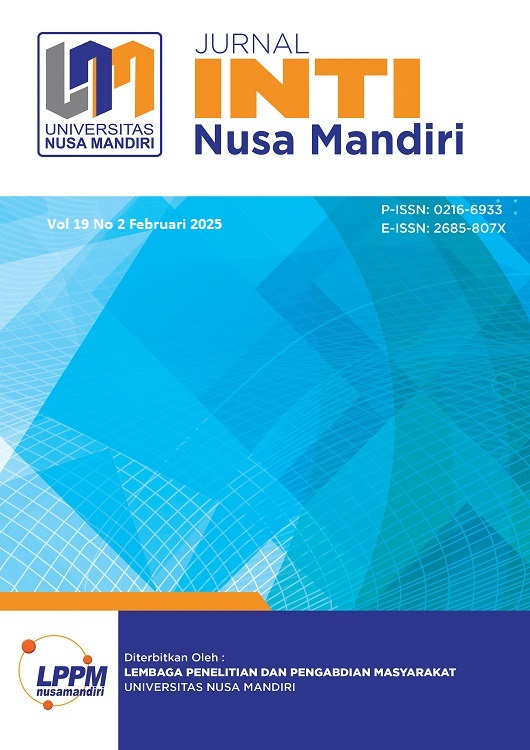IMPLEMENTASI YOLOV5 UNTUK DETEKSI KARTU DEBIT: STUDI KASUS PADA KLASIFIKASI BRITAMA DAN SIMPEDES
DOI:
https://doi.org/10.33480/inti.v19i2.6155Kata Kunci:
debit card classification, deep learning, object detection, YOLOv5Abstrak
This study aims to develop an object detection model based on YOLOv5 to classify debit card types. With the advancement of financial technology, the need for automated systems to identify debit cards has become essential to enhance transaction efficiency and security. The research methodology involves five main stages: dataset collection, data preprocessing through labeling and resizing to 640 x 640, dataset augmentation, YOLOv5 model training, and model evaluation. The dataset used consists of three categories of debit cards, with a total of 300 images. The results demonstrate that the YOLOv5 model achieves excellent performance with a mean average precision (mAP) of 92.7% and an object loss value of 0.08. The high mAP value indicates the model’s capability to accurately recognize objects, while the low object loss value reflects minimal detection errors during testing. In conclusion, YOLOv5 has proven to be reliable for application in debit card detection systems. This study provides significant contributions to the development of automation systems in the financial sector, particularly in improving the efficiency and accuracy of identification processes. It is hoped that this research will serve as a foundation for further studies with broader datasets, the application of more advanced augmentation techniques, and the utilization of more sophisticated hardware to enhance model performance.
Unduhan
Referensi
Arby, F. H., Husni, I., & Amin, A. (2022). Implementation of YOLO-v5 for a real-time Social Distancing Detection. Journal of Applied Informatics and Computing. 6(1), 1–6. https://doi.org/10.30871/jaic.v6i1.3484
Chen, Y. W., & Shiu, J. M. (2022). An implementation of YOLO-family algorithms in classifying the product quality for the acrylonitrile butadiene styrene metallization. International Journal of Advanced Manufacturing Technology. https://doi.org/10.1007/s00170-022-08676-5
Chethan Kumar, B., Punitha, R., & Mohana. (2020). YOLOv3 and YOLOv4: Multiple object detection for surveillance applications. Proceedings of the 3rd International Conference on Smart Systems and Inventive Technology, ICSSIT 2020, Icssit, 1316–1321. https://doi.org/10.1109/ICSSIT48917.2020.9214094
Departemen Penelitian dan Pengaturan Perbankan Otoritas Jasa keuangan. (2021). Cetak Biru Transformasi Digital Perbankan. https://www.ojk.go.id/id/berita-dan-kegiatan/info-terkini/Documents/Pages/Cetak-Biru-Transformasi-Digital-Perbankan/CETAK%20BIRU%20TRANSFORMASI%20DIGITAL%20PERBANKAN%20(SHORT%20VERSION).pdf
Helfasari, N. A., Gamayuni, R. R., & Syaipudin, U. (2021). Cashless Banking and Financial Performance of Bank Rakyat Indonesia. ICEBE 2020: Proceedings of the First International Conference of Economics, Business & Entrepreneurship, ICEBE 2020, 1st October 2020, Tangerang, Indonesia, 22.
Hesananda, R., & Agustian, E. Y. (2024). Generasi Z dan Data Mining: Panduan Klasifikasi Pinjaman Bank sebagai Data Analis Keuangan. Penerbit NEM. https://books.google.co.id/books?id=t-3tEAAAQBAJ
Hesananda, R., Noviani, I. A., & Zulfariansyah, M. (2024). Implementasi YOLOv5 untuk Deteksi Objek Mesin EDC: Evaluasi dan Analisis. BIOS: Jurnal Teknologi Informasi Dan Rekayasa Komputer, 5(2), 104–110. https://doi.org/10.37148/bios.v5i2.127
Iman, N., Nugroho, S. S., Junarsin, E., & Pelawi, R. Y. (2023). Is technology truly improving the customer experience? Analysing the intention to use open banking in Indonesia. International Journal of Bank Marketing, 41(7), 1521–1549. 10.1108/ijbm-09-2022-0427
Iyer, R., Ringe, P. S., & Bhensdadiya, K. P. (2021). Comparison of YOLOv3, YOLOv5s and MobileNet-SSD V2 for real-time mask detection. Artic. Int. J. Res. Eng. Technol, 8, 1156–1160.
Jikrillah, S., & Fadah, I. (2023). Financial Performance of Indonesia Banking: The Impact of Digital Banking. ICIFEB 2022: Proceedings of the 3rd International Conference of Islamic Finance and Business, ICIFEB 2022, 19-20 July 2022, Jakarta, Indonesia, 281.
Kıvrak, O., & Gürbüz, M. Z. (2022). Performance comparison of yolov3, yolov4 and yolov5 algorithms: A case study for poultry recognition. Avrupa Bilim ve Teknoloji Dergisi, 38, 392–397.
Kuznetsova, A., Maleva, T., & Soloviev, V. (2021). YOLOv5 versus YOLOv3 for apple detection. In Cyber-Physical Systems: Modelling and Intelligent Control (pp. 349–358). Springer.
Mulyana, R., Rusu, L., & Perjons, E. (2023). How Hybrid IT Governance Mechanisms Influence Digital Transformation and Organizational Performance in the Banking and Insurance Industry in Indonesia. The International Conference on Information Systems Development (ISD), 1–12.
Nepal, U., & Eslamiat, H. (2022). Comparing YOLOv3, YOLOv4 and YOLOv5 for autonomous landing spot detection in faulty UAVs. Sensors, 22(2), 464.
PT Bank Mandiri (Persero) Tbk. (2021). Melanjutkan Transformasi Digital & Inovasi Perbankan. https://www.idx.co.id/StaticData/NewsAndAnnouncement/ANNOUNCEMENTSTOCK/From_EREP/202202/ef15dbcba6_0a7f8a125f.pdf
Redmon, J., Divvala, S., Girshick, R., & Farhadi, A. (2016). Yout Only Look Once: Unified, Real-Time Object Detection. 27(3), 306–308. https://doi.org/10.1021/je00029a022
Sarosa, M., Muna, N., Elektro, J. T., Malang, P. N., Korespondensi, P., Korban, D., Objek, D., & Only, Y. (2021). Implementasi Algoritma You Only Look Once ( Yolo ) Untuk Implementation of You Only Look Once ( Yolo ) Algorithm for. 8(4), 787–792. https://doi.org/10.25126/jtiik.202184407
Tristanto, T. A., Nugraha, N., Waspada, I., Mayasari, M., & Kurniati, P. S. (2023). Sustainability performance impact of corporate performance in Indonesia banking. Journal of Eastern European and Central Asian Research (JEECAR), 10(4), 668–678. https://doi.org/10.15549/jeecar.v10i4.1364
Wardhani, D., & Wijaya, A. P. (2020). User Interface Prototype Design Of Mobile Application Academic Information Systems Institute Of Technology And Business Of Indonesian Banks. BRITech (Jurnal Ilmiah Komputer, Sains Dan Teknologi Terapan), 1(2), 25–31.
Yusro, M. M., Ali, R., & Hitam, M. S. (2023). Comparison of faster r-cnn and yolov5 for overlapping objects recognition. Baghdad Science Journal, 20(3), 893. https://doi.org/10.21123/bsj.2022.7243
##submission.downloads##
Diterbitkan
Cara Mengutip
Terbitan
Bagian
Lisensi
Hak Cipta (c) 2025 Rizki Hesananda, Vian Firmansyah

Artikel ini berlisensi Creative Commons Attribution-NonCommercial 4.0 International License.
Penulis yang menerbitkan jurnal ini menyetujui ketentuan berikut:
1. Penulis memegang hak cipta dan memberikan hak jurnal mengenai publikasi pertama dengan karya yang dilisensikan secara bersamaan di bawah Creative Commons Attribution 4.0 International License. yang memungkinkan orang lain untuk berbagi karya dengan pengakuan atas karya penulis dan publikasi awal pada jurnal.
2. Penulis dapat memasukkan pengaturan kontrak tambahan yang terpisah untuk distribusi non-eksklusif dari versi jurnal yang diterbitkan (misalnya, mengirimkannya ke repositori institusional atau menerbitkannya dalam sebuah buku), dengan pengakuan atas publikasi awalnya pada Jurnal.
3. Penulis diizinkan dan didorong untuk memposting karya mereka secara online (misalnya, dalam penyimpanan institusional atau di situs web mereka) sebelum dan selama proses pengiriman, karena hal itu dapat menghasilkan pertukaran yang produktif, serta kutipan dari karya yang diterbitkan sebelumnya.











